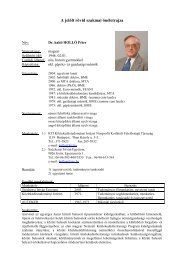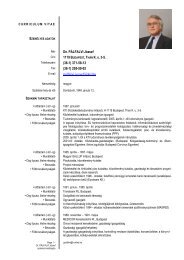VISION: Road Transport in Europe 2025 - FEHRL
VISION: Road Transport in Europe 2025 - FEHRL
VISION: Road Transport in Europe 2025 - FEHRL
Create successful ePaper yourself
Turn your PDF publications into a flip-book with our unique Google optimized e-Paper software.
Under the Market-Led scenario users would be required to pay for <strong>in</strong>formation on predicted journey times and for<br />
real-time <strong>in</strong>formation dur<strong>in</strong>g the journey. They would also be required to pay for improved levels of service, for<br />
example more reliable routes would be available through the use of tolls. Wherever alternatives which <strong>in</strong>volved<br />
payment were available, pric<strong>in</strong>g would be <strong>in</strong>strumental <strong>in</strong> achiev<strong>in</strong>g a balance between traffic flows and reliability.<br />
In the Susta<strong>in</strong>able-Society scenario the emphasis on durable <strong>in</strong>frastructure would reduce ma<strong>in</strong>tenance needs and<br />
consequent disruption. The more general move towards susta<strong>in</strong>able lifestyles - with the planned rebalanc<strong>in</strong>g of<br />
transport and land-use - would have the effect of limit<strong>in</strong>g or reduc<strong>in</strong>g demand for certa<strong>in</strong> journey types. As far as<br />
possible, alternative modes would be provided for those journeys that were required.<br />
In the Ideal-World scenario fast construction and ma<strong>in</strong>tenance and highly desirable roads would m<strong>in</strong>imise disruption.<br />
Real time <strong>in</strong>formation about network conditions will be available to users to enable them to plan their journeys.<br />
Availability of ACCESS<br />
Requirement<br />
Travel should provide full access to dest<strong>in</strong>ations <strong>in</strong> relation to need and economic value; it should be socially<br />
<strong>in</strong>clusive.<br />
Developments<br />
The purpose of travel is to undertake activities such as work, school, shopp<strong>in</strong>g and leisure. These activities<br />
could be made more accessible through land-use plann<strong>in</strong>g that located the workplace near schools, shops and<br />
leisure activities and with<strong>in</strong> easy reach of the home. Access to these should not discrim<strong>in</strong>ate by age, <strong>in</strong>come<br />
or physical ability.<br />
The use of IT and telecommunications to provide a grow<strong>in</strong>g network of connections for home work<strong>in</strong>g and<br />
bus<strong>in</strong>ess and workplace activities, along with retail supply-cha<strong>in</strong> l<strong>in</strong>kages, will constitute a profound <strong>in</strong>crease<br />
<strong>in</strong> accessibility. This will complement physical travel. As we have already said earlier the evidence so far is that<br />
these activities do not automatically substitute for physical travel; rather, so far they have added to it,<br />
constitut<strong>in</strong>g an additional raft of activity driven by greater opportunities for accessibility.<br />
It would, we believe, be possible to <strong>in</strong>duce some substitution by selective policies aimed at some journey<br />
types, <strong>in</strong>clud<strong>in</strong>g the use of pric<strong>in</strong>g mechanisms; but over the next twenty years it seems more likely that social<br />
and work patterns will absorb the new possibilities for access organically - much as they have so far for the<br />
<strong>in</strong>ternet and mobile phones. In other words, they will not remove a significant part of the need for the<br />
provision and management (<strong>in</strong> the broadest sense) for access by physical movement.<br />
57






